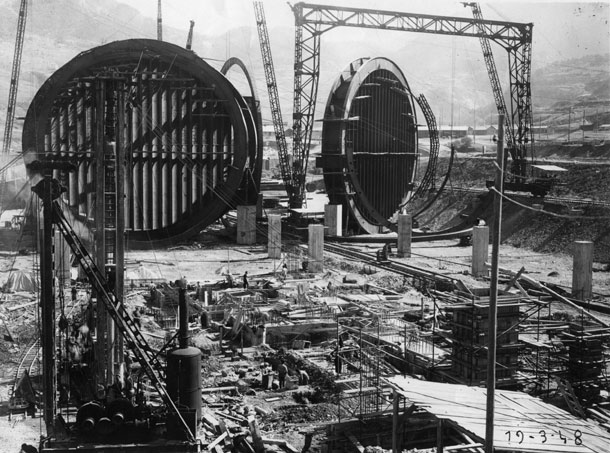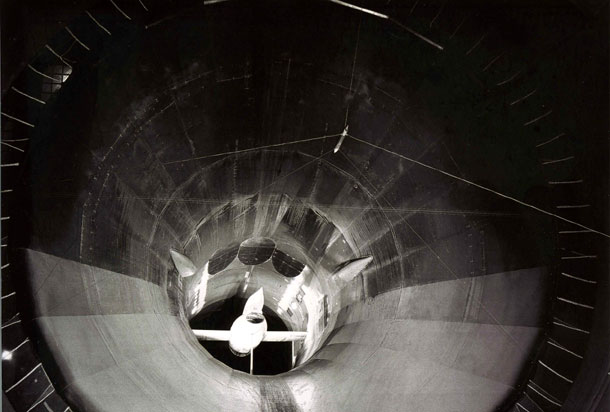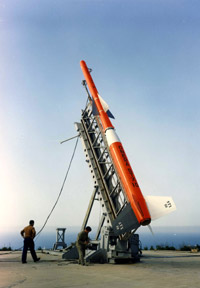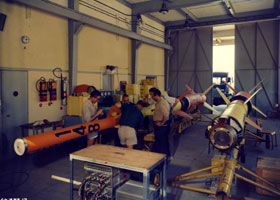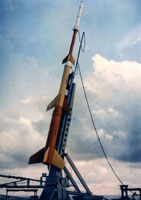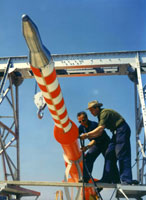- ONERA
- About ONERA
- History
- 1946 to 1962: aeronautical research that is rapidly gaining momentum
1946 to 1962: aeronautical research that is rapidly gaining momentum
The scientific activity is organized into five scientific divisions dedicated to the basic fields: Aerodynamics, Energy, Materials, Structure Resistance and General Physics.
Research on aerodynamics was related to wing calculation, to swept wings and stabilizers for supersonic flight and to the interaction between shock waves and boundary layers on the wings in transonic flight. Applied research provided manufacturers with a veritable catalogue of results on aircraft components: fuselage shapes, wing profiles, air intakes, side control devices, etc.
In Chalais-Meudon, the large subsonic wind tunnel S1Ch, which dates back as far as 1935, contributes significantly to basic studies on high-lift, for example, the Short Take Off and Landing (STOL) high-lift flaps of the Breguet 941. Tests on models of the Caravelle and Concorde were conducted in the continuous-operation transonic wind tunnel S3Ch. In the fifties, all French fighter and bomber aircraft prototypes were tested on small models in the continuous-operation supersonic wind tunnel S5Ch. The goal? To remedy serious problems in transonic flight which cost many test pilots their life. Breaking the sound barrier was simulated for the first time in 1953 on a model of the Mystère II.
In Modane-Avrieux, the S1MA wind tunnel, whose construction was carried out in stages between 1945 and 1951, enabled tests to be performed on aircraft components and even qualification tests before flight: the ramjet of the Arsenal de l’Aéronautique (an agency located in Châtillon), the jet deflector of the Vampire, the CT20 target aircraft, missiles (Otomat and Exocet), the Mystère IV and the turbo-ramjet of the Griffon. Many military supersonic programs - between Mach 1.3 and Mach 3.1 - were tested in the S2MA wind tunnel.
From the beginning, large teams (of 150 to 200 people) were assigned to the study of liquid propellant and solid propellant rocket engines, ramjets and turbomachinery. In particular, in 1951 in Hammaguir in Algeria, ONERA launched its Stataltex ramjet, which for a long time held the world record for speed and altitude for target devices of its class, reaching Mach 5 at an altitude of 38 km.
For airframes, research related to the resistance to long term creep of aluminum alloys. For engines, studies were dedicated to the aluminization processes (chrome/aluminum coating) which had been long used for turbine blade protective coatings. Original studies also concerned nickel and cobalt based heat resistant super alloys. ONERA partnered with the CNRS and Université de Paris-Sud Orsay to perform high-level expert assessments with electron microscopy.
The first studies on structures related to the absolute need to control the aeroelastic flutter phenomenon in aircraft structures; this phenomenon can have catastrophic consequences, such as the fatal crash of the Arsenal VG 90-02 jet piloted by Claude Dellys in 1952. Since that date, no French prototype has flown without having been previously subjected to ground tests based on methods developed at ONERA. In the early 1960s, the Concorde program revealed the need for methods to forecast viscoelastic behavior and material damage for airframes.
Sensors and instruments needed for measuring the aerodynamic and aerothermodynamic characteristics of flows and for performing aeroelastic measurements on structures were thus developed: pressure sensors, temperature sensors, weighing scales, strain gauges, etc.
ONERA organized numerous in-flight rocket and craft test campaigns, with all means necessary in terms of measurement, telemetry and trajectography. One worthy of mentioning is the launch in 1959 of the Antares four-stage rocket, the first French space rocket for the systematic study of phenomena related to reentry. Then came the Berenice rockets for tests at Mach 12.
On peut ainsi répertorier en 1959 le lancement de la fusée Antarès à quatre étages, première fusée spatiale française pour l’étude systématique des phénomènes liés à la rentrée dans l’atmosphère. Succèderont ensuite les fusées Bérénice pour des essais à Mach 12.
Photo credits:
- ONERA
- Yves Aurenche, retired ONERA engineer
References:
- Nouvelles de l'ONERA (ONERA News) No. 7, June 1966, notes and recollections of the founding of ONERA, by Jean Dubois
- 50 ans de recherches aéronautiques et spatiales (50 years of aerospace research), © ONERA - Paris, 1997.
- Histoire de l'Aviation pour les Nuls (History of Aviation for Dummies), Philippe Benhamou , First Editions, 2010.
- Comaero, un demi-siècle d'aéronautique en France (Comaero, half a century of aeronautics in France), Studies and Research (I) the CHEAr notebooks, Chapter 1, Pages 13-14
- wikipedia.fr



